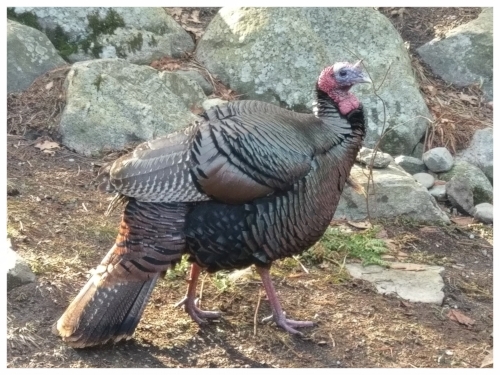February 26, 2017 – Wildlife

The bald eagle was not Ben Franklin’s idea of a noble American symbol. He called it a “bird of bad moral character” referring to his observations of them stealing fish caught by other birds. Franklin preferred the turkey, which he admitted was, “a little vain and silly” but earned an honest living, and was by his estimation, ”a true original native of America.”
I have nothing poor to say about our nation’s bird of choice, but I’ve got to admit intrigue and admiration of the wild turkey. I had occasion to visit relatives this past weekend whose home borders conservation area. The resident turkey flock is right at home on their back patio, taking advantage of the sunflower seed proffered them. By no means shy, this flock of toms (mature males) and jakes (immature males) allowed me a close-up inspection.
Tom turkey plumage is tremendously iridescent. Green, gold, blue, bronze all shimmer in the sunlight all over their bodies, except for their red scaly legs and blue and red nearly-naked heads. The fleshy head must be visible because the hens need to see all the exciting protuberances and colors that are apparently so attractive.
The bumps on the head and neck are called caruncles. The three large ones at the base of the neck get bigger when females are around. Showing red against blue flesh must be quite eye-catching to hens.
The funniest facial appendage, I think, is the snood. It’s that fleshy knob on the forehead at the base of the beak. At this time of year it is a little knob, either drooping or erect. When the ladies come around, it becomes engorged with blood and dangles down over the bill. Hens seem to know that the best choice is he who has the longest snood!
Don’t forget the wattle, or dewlap, that extends along the neck under the chin. This flap of skin changes color with a tom’s mood: blue with apprehension, pale with ease or illness and bright blood red during courtship.
Then there’s the beard: a bundle of specialized feathers in the middle of the chest that look like hairs; short on young jakes but 9” long on an old tom.
Finally I check out the spurs on the legs. As in roosters, toms use these as formidable weapons; jakes spurs grow as they age.
An amazing amalgam of interesting parts (from my perspective) and appealing appendages (from the turkey hens’ perspective), the tom wild turkey is hard to ignore.